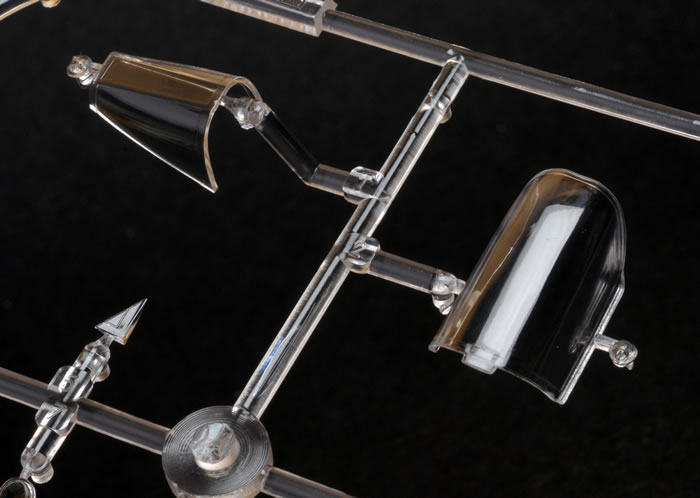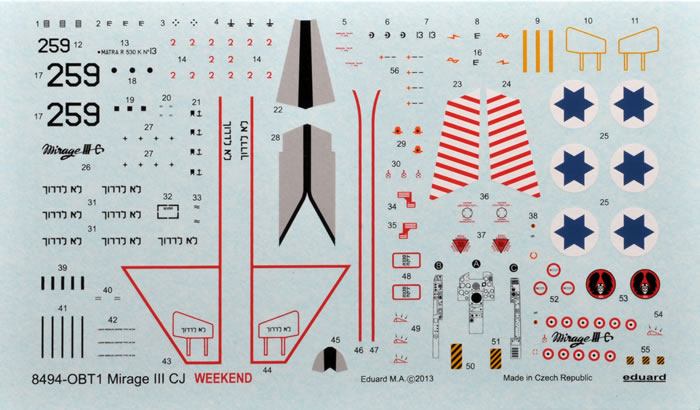|
Mirage IIICJ
Weekend Edition

Eduard, 1/48 scale
S
u m m a r y |
| Catalogue Number: |
Eduard Kit No. 8494 - Mirage IIICJ Weekend Edition |
| Scale: |
1/48 |
| Contents and Media: |
143 injection medium grey coloured moulded parts; 9 clear injection moulded parts; markings for one aircraft |
| Price: |
467,50 K? plus shipping,
available online from Eduard |
| Review Type: |
FirstLook |
| Advantages: |
Crisply moulded; easy assembly. |
| Disadvantages: |
|
| Conclusion: |
This is a very nice kit and one that is quite easy to build.. Highly Recommended. |
Reviewed by Brett Green

Eduard's 1/48 scale Mirage IIICJ Weekend Edition is available online from Squadron.com
Eduard continues with its 1/48 scale Weekend Edition kits, which are re-boxings of their standard and ProfiPACK kits without the etched metal parts and with only one colour scheme. This time they have focussed on their Dassault Mirage CJ kit that was first released in about 2004. Although I have built both the Eduard Mirage C and CJ profipack kits I have not posted a review in either the in box or built format. For this reason I will start from scratch even though there are many reviews of the Eduard Mirage on different web sites including Hyperscale.
The kit contains approximately 143 injection medium grey coloured moulded parts and 9 clear injection moulded parts. Eight of the medium grey injection moulded parts are not used for this version of the Mirage.
The kit contains the following stores:
2 x AIM 9D Sidewinder air to air missiles,
2 x Matra 530C/K air to air missiles,
2 x Matra 530E/M air to air missiles,
2 x 500L external supersonic fuel tanks,
2 x 625L external subsonic fuel tanks, and
2 x Matra JL-100 Rocket Pods.
There are two missiles that I cannot identify but they look like captive CATM or dummy DATM versions of the Matra 550 air-to-air missile that was never carried on the Mirage IIIC.
The detail is finely recessed and looks to be very accurate when compared to the line drawings. The shape overall is very accurate. I have read other reviews that state that the windscreen was inaccurate, but it conforms to the drawings and unless the IIIC differs from the IIIO it looks to be the same as I remember when I worked on the IIIO.

Construction starts with the cockpit, which is made up from 17 parts. The ejection seat is a bit on the average side and I would replace it with a resin Martin Baker Mk.4 seat from an aftermarket source. Decals are provided for the instrument panel and side console to enhance the detail. The instrument panel and the side panels have nice raised detail that can be painted instead of using the decals.
The engine detail is quite nice and includes a full-length afterburner that ends with the early Atar engine 09B eyelid aperture. The main wheel wells are sufficiently detailed and comprise of six parts. Likewise, the nose wheel well is made up from seven parts and is also nicely detailed.
The intakes have nice ducting that lead back as far as the eye can see on the real aircraft. You cannot see the engine compressor on the aircraft unless you almost put your head inside the intake so it would not matter that no compressor face is included.
A key inclusion in the kit is the separate elevons and pitch dampers as when the hydraulic system is not pressurised the elevens will droop to the full down position. The only issue is the actuators are provided in the streamlined position but these are easily modified to represent the drooped position.
The undercarriage legs and wheels have excellent detail with the wheels being the high pressure tyres rather than the low pressure tyres of the IIIE. Eduard has correctly supplied the flatter main wheel flipper doors rather than the bulged flipper doors introduced on the IIIE to cover the wider low pressure tyres.
A pilot and boarding ladder are also included to allow the modeller to display the aircraft in a diorama setting
Markings
Eduard provides markings in the weekend edition for one aircraft:
Mirage IIICJ No259 of the 101st Tayaset, Chel Ha’ Avir operation branch in summer 1970.

The aircraft is finished in Tan, light green and sand upper surfaces and light blue under surfaces.
This is a very nice kit and one that is quite easy to build. The only build issue that I recall was having to use a length of plastic sprue to spread the fuselage to meet the wing width, otherwise the kit is easy to build.
The included colour scheme is very attractive and the final assemble kit looks very impressive.
The standard kit includes a nose weight that is not included in the Weekend kit. The kit is marginal on centre of gravity and it would be best to add a little weight to the nose cone.
Suitable for moderate modelling skills.
Highly Recommended.
Thanks to Eduard for the sample
Review Text Copyright © 2014 by Mick Evans
Images Copyright © 2014 by
Brett Green
Page Created 6 February, 2014
Last updated
18 February, 2014
Back to HyperScale Main Page
Back to Reviews Page |
